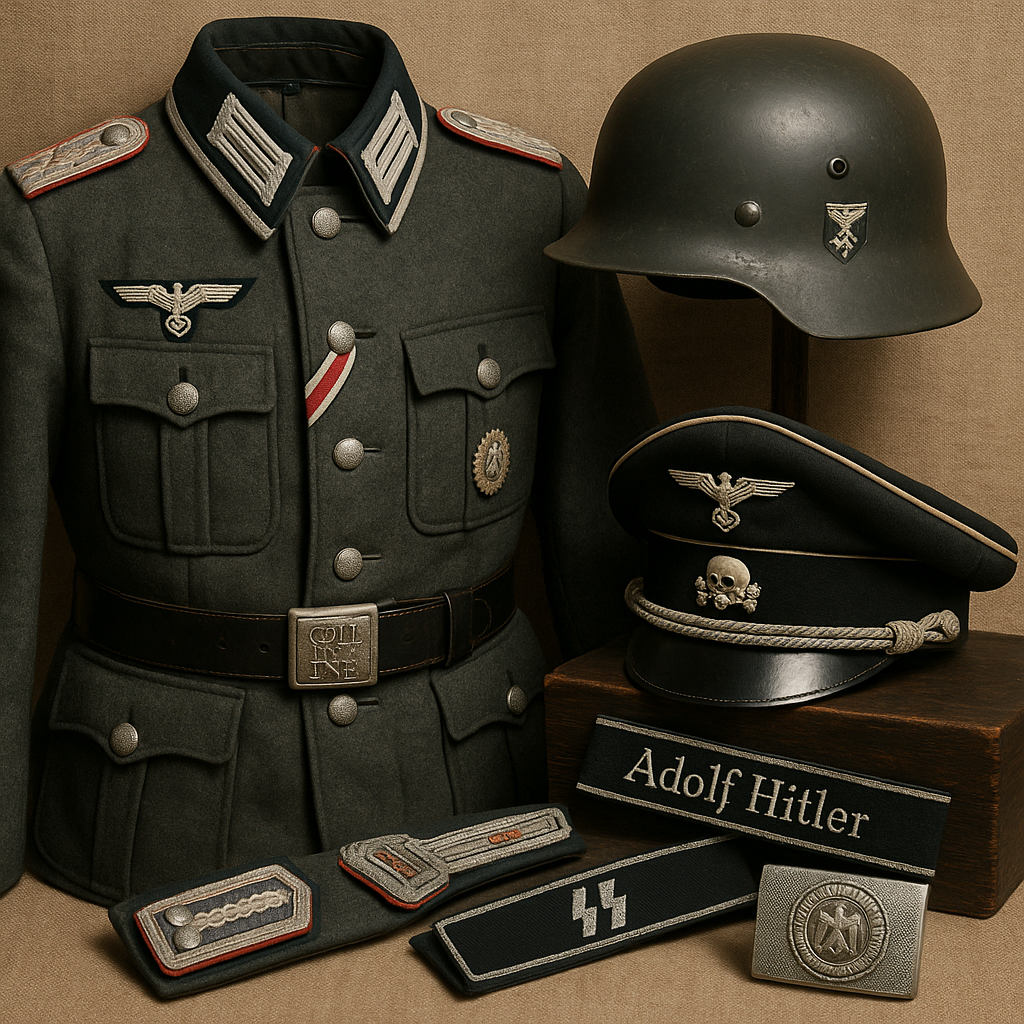
Nazi Uniform Accessories: A Deep Dive into WWII German Military Attire
Published on Apr 17, 2025
Nazi Uniform Accessories: Uncovering the Details Behind WWII German Military Attire
The Role of Uniforms in Nazi Germany
During World War II, Nazi Germany was known for its highly structured military system and visually striking uniforms. But these uniforms were more than just fabric — they were tools of identification, propaganda, and control.
Each piece of a German soldier’s uniform, from the boots to the epaulets, had a purpose. Nazi uniform accessories played an essential role in conveying military status, experience, division, and even ideology. Their design wasn’t random — it followed strict regulations developed by the Wehrmacht and SS.
German Sergeant WWII Shoulder Boards: A Symbol of Rank and Authority
One of the most identifiable Nazi uniform accessories was the shoulder board. German sergeant shoulder boards from WWII were designed to convey rank clearly, even from a distance.
Key Features:
- Braiding & Piping: Non-commissioned officers (NCOs), like sergeants, wore shoulder boards with intricate silver braiding and colored piping, which indicated the branch of service — infantry, armor, signals, etc.
- Pips: Small metal stars (called pips) denoted seniority. A sergeant might wear one pip, while a senior sergeant could wear two or more.
- Backing Material: Often made of wool, matching the tunic color. Elite divisions had specific backings, like black for Panzer units.
These details made the shoulder board not just an accessory but a critical piece of battlefield communication.
Other Common Nazi Uniform Accessories
Beyond shoulder boards, Nazi uniforms featured numerous accessories that helped structure the hierarchy and identity of the military.
1. Collar Tabs (Kragenspiegel)
- Used mainly by officers and SS personnel.
- Indicated rank, regiment, and sometimes even battle honors.
- SS collar tabs were especially symbolic, featuring runes and skull insignias.
2. Cuff Titles (Ärmelstreifen)
- Worn on the lower sleeve.
- Embroidered with the unit’s name (e.g., “Grossdeutschland” or “Adolf Hitler”).
- Often issued as awards for elite status.
3. Belt Buckles
- Featured propaganda slogans like “Gott mit uns” (God with us) or SS symbols.
- Some had hidden compartments allegedly used to conceal cyanide pills in case of capture.
4. Cap Insignias and Eagle Patches
- Worn on visor caps, field caps, and helmets.
- Common motifs: eagle clutching a swastika, Totenkopf (death’s head).
- Denoted allegiance to either Wehrmacht or SS.
These items weren’t just decorative — they were meticulously designed to reinforce the Nazi regime’s ideology, instill fear, and build loyalty among troops.
Old Military Clothing and Its Historical Value
There’s an ever-growing community of collectors, historians, museums, and reenactors who seek old military clothing to understand history better. Original WWII German military garments — especially authentic Nazi uniform accessories — are valuable for:
- Preservation of Historical Accuracy: Museums use these items for accurate WWII displays.
- Reenactment & Education: Historical groups recreate battles or presentations using original gear to offer immersive educational experiences.
- Military Fashion Research: Designers and fashion historians study the tailoring and fabrics used, which were often ahead of their time.
However, it’s important to collect and display these artifacts with care, understanding their association with a dark chapter in history.
Ethical Considerations When Dealing with WWII Nazi Memorabilia
There’s an ongoing debate surrounding the sale and collection of Nazi memorabilia. While items like German sergeant WWII shoulder boards have educational and historical value, they can also be misused or misunderstood.
Best Practices for Collectors and Sellers:
- Ensure Authenticity: Only collect from trusted dealers or certified historians.
- Avoid Glorification: Focus on education and remembrance, not admiration.
- Comply with Laws: In many countries, symbols like the swastika are illegal to sell or display without a historical context.
As a seller or buyer of these items, presenting them with proper context is crucial to maintaining ethical standards.
Can Germany Have an Army After WW2?
After the fall of Nazi Germany in 1945, one of the most pressing questions was whether the country could ever rebuild its military. The short answer is yes — but it was a complex, heavily regulated process.
The Transition:
- Demilitarization (1945–1955): All military forces were dissolved. The Allied powers occupied Germany.
- Cold War Pressure: With tensions rising between the U.S. and the Soviet Union, the West needed a strong ally in Europe.
- Bundeswehr Established (1955): West Germany was allowed to form a new military under NATO. This modern army was built on democratic values, transparency, and civilian oversight.
Today, Germany maintains a professional army — the Bundeswehr — with a strict focus on peacekeeping, defense, and international cooperation. It’s a powerful contrast to the authoritarian military legacy of WWII.
WW2 War Helmets: Protection and Prestige
Tying into our pillar content, WWII German war helmets were more than protective gear. Helmets like the iconic Stahlhelm were symbols of elite status and combat readiness.
Types of Helmets:
- M35/M40/M42 Stahlhelms: Used by Wehrmacht and Waffen-SS. Known for their rugged design and distinctive profile.
- Helmet Decals: Many helmets bore national insignias or divisional markings.
- Camouflage Covers: Troops in Africa or Russia used painted or cloth covers to adapt to terrain.
These helmets are often collected alongside uniform accessories, completing a soldier’s ensemble for collectors and reenactors alike.
Conclusion: Preserving History, Not Glorifying It
Understanding the complexity of Nazi uniform accessories helps paint a fuller picture of how military imagery was used for power and control. From German sergeant WWII shoulder boards to iconic helmets and insignia, each piece tells a story.
As we study and preserve these artifacts of old military clothing, we must do so with integrity, mindfulness, and a focus on education. And while Germany’s military past is dark, its transformation into a modern, democratic force proves that nations — like people — can change.
